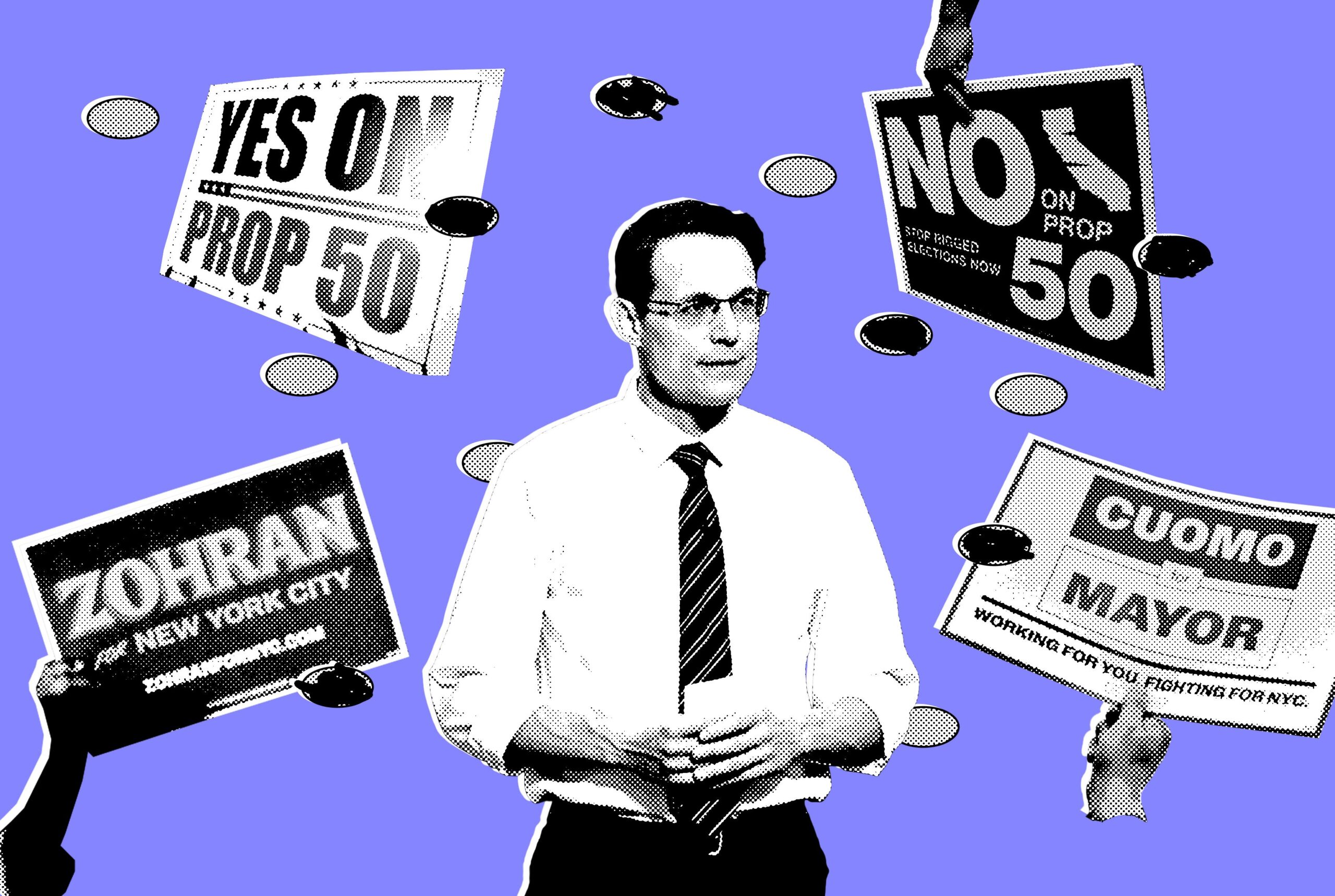If you’re like me, Steve Kornacki is just as adored by your aunt as he is in your group chats. He’s become a staple of Election Day coverage, putting in long hours at the big board and copious amounts of prep beforehand.
His granular knowledge of key counties and voter turnout trends made him not just indispensable for many Americans on election night, but also a full-blown celebrity. I caught up with him bright and early this morning to talk about Tuesday night’s election results.
We broke down what the returns mean heading into the 2026 midterm elections, where Democrats currently hold an 8 percentage point advantage over Republicans in the latest NBC News poll, and what they say about President Donald Trump’s second-term agenda. We also spoke about what surprised him in the New Jersey governor’s race, whether Trump’s base is weakening, and, of course, New York mayor-elect Zohran Mamdani’s historic win. Heading into the midterms, Kornacki is taking on an expanded role at NBC News following parent company Comcast’s decision to spin off its cable TV properties, including a soon-to-be rebranded MSNBC.
Kornacki is not someone to put too much stock into an off-year election, but the breadth and depth of Democratic victories suggested a political environment that’s radically changed in the year since Trump’s election—and if anyone can find some important details to follow going forward, it’s Steve.
This interview has been edited for length and clarity.
WIRED: Steve, thanks for joining us after a long night. Before we get into the meat and potatoes here, let’s start with a quick lightning round: How many hours of sleep were you shooting for, how many did you get, and can you tell us if you have any election night superstitions?
Steve Kornacki: Well, I shoot for zero, so I’m not disappointed and therefore I’m pleasantly surprised with whatever I get, which I think was about two and a half last night.
There we go.
So that’s not too bad. Superstitions? I don’t know about that. My challenge is to just tune out all the anecdotal turnout data on Election Day. I just think it’s a ton of noise that starts messing with your head.
What surprised you from last night?
What surprised me was—it’s probably not the most original observation this morning—but New Jersey. [Representative Mikie Sherrill, the Democratic nominee, won with more than 56 percent of the vote.] The margin there for Sherrill, which is about 13 points, is much more than expected. I mean, I was talking to Democrats right up through Election Day who were telling me some version of: “She’s run a terrible campaign, she’s not been a good candidate. Maybe she’ll still win because of Trump, but this is going to be closer than it should be.” I mean, that was a widely shared view between the two parties, that Sherrill had run a bad campaign and was in danger of even losing, and that was not the case at all.
There’s been so much analysis of what Zohran Mamdani means for the future of the Democratic party. Looking at his turf from last night, where did he perform the strongest and the weakest? And what might those precincts say about the potential and limits of a candidate like him?
I think a lot of it’s consistent with what we saw in the primary and, pardon me, probably isn’t too shocking. Borough Park—one of the larger Jewish populations you’re going to find in the city, it’s majority Jewish. Cuomo won there by 74 points in the primary, and we’re seeing a similar result yesterday. Flip it completely around though, when you go to Park Slope. The core is a younger median age, a lot of college degrees, a lot of young professional types, creative types. And again, that was a 60-point win for Mamdani in the primary, and again, very comparable last night. So a lot of it were patterns I think that we saw in the primary kind of repeating themselves. Look, it was 56 to 44 in the primary, and last night looks like it’s going to land at about 50 to 41.
Zooming out to both sides of the Hudson: What do you make of the rest of the results in New York City and in New Jersey, and what might those say about the state of the Democratic base?
I think two things happened in New Jersey: Four years ago, when Jack Ciattarelli almost won the governorship, he defied expectations and did much better than expected with a set of voters who tended to be suburbanites, college educated. Places like Morris County, Somerset County, Bergen County. These are areas that are pretty hostile to Donald Trump. But in 2021, Ciattarelli was able to make some really big inroads.
With Trump back in the White House, these voters were now cross-pressured. They don’t like Trump. They had kind of liked Ciattarelli four years ago—when you look at these returns, the antipathy to Trump is what won out. In Hudson County, you’ve got several midsize cities there that are like 75 percent Hispanic, where Trump made massive, massive inroads in 2024. And that result of 50 points in Sherrill’s favor is basically back to where things started.
Republicans were really hopeful in New Jersey, and we know nationally coming out of 2024 about this multiracial coalition that Trump had put together. The question was, could a candidate without the name Donald Trump do it too? Was he tapping into something that was broader than just a Trump phenomenon? Was it a Republican-versus-Democrat phenomenon?
And at least last night, in the places where we can measure it, you don’t see it at all being a Republican phenomenon.
In terms of Trump’s base and his support among independents, did you see any softening among those voters?
The opposition party walks into these elections with an advantage. And I think one of those advantages when you’re talking about independent voters and swing voters is the opposition party becomes the protest vehicle. So whatever issue you have with the White House, with the party that controls Washington, whatever displeasure you have, the way to express it often is to vote for the opposition party.
Now, this has evolved a little bit through the years, I think as people have gotten more partisan, but I think it’s still very much a factor. And so I think when I look at these results, I think there’s definitely an element of that. Having Trump back in the White House, Republicans in control of Congress, and the fact that Trump on our poll clocks in at a 43 percent approval rating imposes a ceiling on Republicans. If you looked at Trump’s approval rating in our exit poll like in Virginia and New Jersey, it tracks almost perfectly with the performance of the Republican candidates.
Let’s talk college vs. non-college voters. Were there any counties from last night that struck you as particularly interesting heading into the midterms, particularly in terms of who’s motivated to show up in an off-year election?
The sort of surge in turnout that Trump generated when he ran for president has come heavily from white voters without college degrees. On the flip side, college-educated white voters in particular have become a more Democratic constituency over the last decade, since Trump arrived on the scene. So when I talk about places like Somerset County in New Jersey, that might actually be the best example of it. That’s Bedminster, that’s Trump’s golf club. That’s a well-to-do area west of New York City. It’s also Jack Ciattarelli’s home county, and Ciattarelli got absolutely clobbered there. When he ran four years ago, this was a very competitive county. This year, he’s losing it by almost 20 points.
That’s what you’re seeing: There are college-educated, white-collar professionals who are very hostile to Donald Trump. So when Trump is front and center on the political stage, this is what you’re going to see in those places.
What do you think the implications are for the GOP in the 2026 election?
Our NBC poll this past week showed Democrats leading by eight points on the generic midterm ballot—that’s much bigger than what we found earlier in the year when we had the Democrats only up by a point. It’s also on the higher end of what’s out there in other polls right now.
I would just encourage folks to look at the results last night. You could look in, say, California, but I would also look inside New Jersey and Virginia within those states. I know people will say they’re blue states, but look at the politically competitive parts of those states. I think you’re seeing movement toward the Democrats and away from the Republicans, and that is very consistent with an eight-point advantage for the Democrats on the generic ballot.
Final question: What else goes into your preparation for a night at the big board? I want to know everything from khaki selection to the little things viewers might not think about, such as how you spend commercial breaks and what you talk about with your producer before going back on air.
I spend weeks, sometimes months before elections, just kind of making maps, county maps, and even yesterday was municipality maps. I bring a whole bundle of maps and spreadsheets with me to the set. When I get a break, I’m usually just taking one of those spreadsheets and just comparing it with the results.
The worst thing that ever happened to me was I had 18 months of research probably in a giant folder last year for the 2024 election. We did overnight, live coverage, and I had it on set with me. They said, “Well, you leave the folder here. If you’ve got to go sleep for a few hours, it’ll be here when you come back.” I came back, it was gone. Nobody knew where it went, and I’m never getting it back.
Oh no! And on the khakis—it’s just become such a phenomenon unto itself. How do you pick the winning pair? How many pairs do you own?
Well, I mean, this is the most fashion I’ll ever talk about, but in full disclosure, these things aren’t khakis. I couldn’t tell you what they are. They’re gray, and they’re comfortable.
But the khaki thing was kind of an accident. Nothing against the product, but it wasn’t like I had this lifelong attachment to khaki pants.
Fantastic.
Yes. Let me leave you with one final thing on New York City that I love, because I’m a history dork. 50-41 looks like it’s going to be the final margin for the mayoral race. Go back to 1977, Andrew Cuomo’s father Mario loses the Democratic primary for mayor and runs as a third-party candidate. He loses 50-41 in the general election.
The ghost of Mario! Thank you so much for speaking with me, Steve.
No problem, thank you.
This is an edition of Jake Lahut’s Inner Loop newsletter. Read previous newsletters here.




